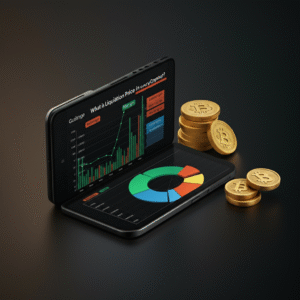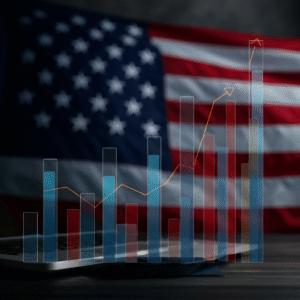Gold has once again become the focus for investors in 2025.
With rising global uncertainty, political tensions, and the Federal Reserve’s policy shifts, traders are looking for safe-haven assets. Gold’s reputation as a store of value makes it a natural choice when markets feel unstable, inflation concerns persist, or currency fluctuations increase.
The key question: Will gold resume its rally or face a correction?
Investors are debating whether gold will continue its upward trend or see a pullback. Factors such as interest rate changes, dollar strength, and geopolitical developments will play a critical role. Understanding these influences can help investors position their portfolios effectively, whether they aim to benefit from potential gains or protect against sudden drops.
Current State of the Gold Market
How gold has performed in 2025: record highs, big moves
In 2025, gold has soared dramatically, establishing itself as one of the stronger assets in uncertain times. During the first half of the year, gold rose about 26 % in U.S. dollar terms, propelled by demand across currencies. World Gold Council Later in the year, the price reached roughly $3,981 per ounce, marking a nearly 45 % year‑to‑date gain. Trading Economics+1
Major recent milestones: central‑bank demand, safe‑haven flows, weakening dollar
Several key milestones are underpinning this surge:
-
Central‑bank buying: Global monetary authorities are continuing to purchase gold in large quantities as part of reserve diversification away from the U.S. dollar. Discovery Alert+1
-
Safe‑haven flows: Geopolitical tensions, trade uncertainties, and weak real yields have increased demand for gold as a store of value. A weaker U.S. dollar is also helping make gold more attractive for international investors. FXStreet
-
Weaker U.S. dollar / lower real yields: As real interest rates (interest rate minus inflation) stay low or negative, the opportunity cost of holding non‑yielding gold falls, boosting its appeal. Equiti Default+1
Summary: Gold is not just in a short‑term rally — it’s showing signs of broader structural demand backed by central banks and global risk factors. However, the market remains sensitive to key variables like USD strength, interest rates, and policy shifts.
Key Drivers for Gold’s Future
Interest rates, real yields & the policy of the Federal Reserve
Gold is highly sensitive to interest rates and real yields (interest rate minus inflation). When the Federal Reserve keeps rates low or signals easing, the opportunity cost of holding gold decreases, making it more attractive. Conversely, higher rates or rising real yields can pressure gold prices, as investors may prefer yield-bearing assets like bonds. Fed policy in 2025 remains a crucial factor in determining gold’s trajectory.
U.S. dollar strength/weakness and inflation trends
Gold prices often move inversely to the U.S. dollar. A weaker dollar makes gold cheaper for international buyers, boosting demand. Inflation trends also play a major role — higher inflation encourages investors to hedge with gold, while low inflation can reduce urgency for safe-haven buying. Monitoring both currency and inflation dynamics is essential for predicting gold’s near-term performance.
Geopolitical risk, global monetary stress, and central‑bank buying
Political tensions, trade conflicts, and economic instability drive safe-haven demand for gold. Central banks continue to accumulate gold to diversify reserves, adding long-term support. Episodes of global monetary stress — like financial crises or sharp stock market corrections — tend to push investors toward gold, reinforcing its role as a defensive asset. These factors together create both immediate and structural influences on gold’s price in 2025.
Arguments for a Recovery (Uptrend)
Why many analysts expect higher gold prices
Many analysts believe gold is set for further gains because several structural and macro factors are lining up. First, central banks around the world are still buying gold to diversify away from traditional assets and currencies. For instance, Deutsche Bank has raised its forecast for gold in 2026 to around $4,000 per ounce, citing strong central‑bank demand, a potentially weaker U.S. dollar, and more likely rate cuts. Reuters+2Investing.com+2
Second, a weakening U.S. dollar and expectations of looser monetary policy from the Federal Reserve reduce the opportunity cost of holding gold (which pays no yield). That makes gold more appealing. Third, geopolitical risk, economic uncertainty, and inflation fears keep gold in high demand as a safe haven.
What could trigger the next leg up
The next leg up for gold could be triggered by a few clear events:
-
A significant increase in central‑bank gold purchases, especially from large economies outside the U.S.
-
A sharp rise in “risk‑off” sentiment — for example, a trade war, a banking crisis, or major global conflict — which tends to drive capital into gold.
-
A renewed shift by the Fed toward rate cuts or accommodation, which weakens the dollar and boosts gold’s relative attractiveness.
For example, analysts at Bank of America say that if investment demand rises another ~14 %, gold could reach $5,000 per ounce in 2026. deVere Group
Recent forecasts and targets for gold in 2026
Here are some recent analyst targets for 2026:
-
Deutsche Bank: ~$4,000/oz average in 2026. Investing.com+1
-
Goldman Sachs: ~$4,900/oz by end‑2026, driven by strong ETF flows and central‑bank demand. markets.businessinsider.com
-
HSBC: Upgraded average forecasts; some scenarios see gold reaching ~$5,000/oz in first half of 2026. The Straits Times+1
These forecasts reflect bullish sentiment for the yellow metal, underpinned by monetary policy, safe‑haven demand, and structural shifts in reserve allocations.
Arguments for a Correction or Fall
What could stop the rally
Despite gold’s strong performance in 2025, several factors could halt or reverse its uptrend. A stronger U.S. economy may push the Federal Reserve to raise interest rates, increasing real yields and reducing gold’s appeal. Similarly, if the U.S. dollar strengthens, gold becomes more expensive for international buyers, dampening demand. Reduced inflation pressures or a slowdown in monetary easing could also weigh on prices.
Technical and behavioural warning signs
From a market perspective, gold is showing signs of being overbought. Investors may engage in profit‑taking after rapid gains, creating short-term downward pressure. Analysts also note “gold fatigue” — a point where market enthusiasm slows, and momentum-driven buying weakens. Technical indicators, such as RSI (Relative Strength Index) and moving averages, hint that a correction could be imminent if selling intensifies.
Medium-term risks
Gold’s medium-term outlook faces additional challenges. Slowing demand in jewellery and industrial uses could limit growth. Regulatory changes in major markets or taxation on bullion could reduce investor appetite. Moreover, increasing mining supply, if not balanced by demand, could add downward pressure on prices. All these factors suggest that while gold has structural support, it is not immune to periodic corrections.
Key Levels & Timing to Watch
Important price levels and support/resistance zones for gold
Gold traders are closely monitoring key price points. Support levels near $3,800–$3,850 per ounce could act as a floor if the market pulls back. On the upside, resistance around $4,100–$4,150 per ounce represents a critical hurdle; breaking above this could trigger the next leg of the rally. Short-term price action around these zones helps investors plan entries and exits while managing risk.
Timeline of upcoming events
Several upcoming events could influence gold prices:
-
Central-bank meetings: Fed and other major central banks’ policy decisions will affect interest rates and liquidity, directly impacting gold.
-
Inflation data releases: U.S. CPI and PCE numbers are key for assessing real yields and safe-haven demand.
-
Geopolitical shocks: Trade tensions, conflicts, or sudden economic crises often push investors toward gold.
How investor sentiment and flows might shift
Investor sentiment can change rapidly. Rising fear or risk-off behavior tends to boost gold demand. Conversely, strong equity markets, rising yields, or reduced inflation concerns may trigger outflows. Monitoring ETF inflows, hedge fund positioning, and on-chain data for gold-backed tokens can give early signals about shifts in market sentiment. Staying alert to these dynamics helps investors adjust positions effectively in 2025–2026.
Practical Implications for Investors
How to position: if you expect recovery vs if you expect a fall
If you expect gold to continue its rally, consider increasing exposure gradually while keeping a portion of your portfolio liquid. Long positions in ETFs, bullion, or gold-backed tokens can capture upside. If you anticipate a correction, it may be wise to reduce holdings, take profits, or use hedging strategies such as options or inverse ETFs to protect against downside.
Balancing gold in your portfolio: hedging vs diversification vs speculation
Gold can serve multiple roles in a portfolio. As a hedge, it protects against inflation, currency weakness, and geopolitical risk. For diversification, gold reduces overall portfolio volatility when combined with stocks, bonds, or crypto. Speculative investors may increase short-term exposure to capitalize on momentum, but this carries higher risk and requires careful monitoring.
Risk management: what to watch, how to protect capital
Key risks include rapid interest rate changes, dollar strength, and sudden geopolitical shocks. Investors should monitor central-bank announcements, inflation data, and market sentiment indicators. Using stop-loss orders, maintaining liquidity, and avoiding over-leverage can protect capital. A balanced approach — combining gold for safety and selective growth assets — is essential in a volatile 2025–2026 environment.
Regional / Emerging Markets Angle
How these global gold dynamics may affect regions like South Asia / Global Market
Gold’s global trends can significantly influence emerging markets, including South Asia. Rising gold prices often lead to increased local demand as investors seek a safe store of value amid global uncertainty. Countries that rely heavily on gold imports may see heightened market activity, while domestic markets may experience volatility as international investors adjust positions.
Currency, inflation and import‑cost implications for local investors
A stronger gold price can put pressure on local currencies, especially if imports rise. For countries like Pakistan, higher gold import costs may contribute to inflation and affect trade balances. Local investors may face higher prices for bullion or coins, but at the same time, holding gold can serve as a hedge against currency depreciation and inflation. Monitoring exchange rates, global gold flows, and domestic demand trends is essential for informed investment decisions in these regions.
Conclusion
Key takeaways: what seems more likely now for gold
Gold in 2025 remains in a strong position due to central‑bank buying, safe-haven demand, and a relatively weak U.S. dollar. While technical signals suggest the possibility of short-term corrections, structural factors such as global monetary uncertainty and geopolitical tensions support a continued uptrend. Overall, recovery and further gains appear more likely than a sustained fall.
Final thought on “recover or fall” for gold and how investors should stay alert
Investors should stay vigilant and monitor key drivers like Fed policy, real yields, inflation data, and geopolitical events. Positioning for upside while managing risk — through diversification, hedging, and maintaining liquidity — is essential. By balancing caution with opportunity, investors can navigate gold’s market in 2025–2026 effectively, ready to respond to either a rally or a temporary pullback.








